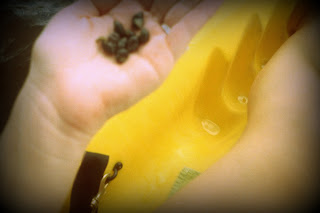While the beaches of my last stop (Panama City) are much prettier than the Atlantic beaches
(sorry... but it's true...), the beaches here have WAY more shells, which are coming in handy for some projects I've been working on
(post coming soon!). And our dog, Haylie, is happy because it means more walks to the beach for shell collecting.
On my last few visits, I've encountered more sea creatures than I've seen in the past year! Perhaps it's the time of year? Whatever the reason, I'm letting my inner nerd out and doing a little research on the critters in my backyard.
This Netted Olive Sea Snail started it all!
The meeting went something like this:
Me (to no one in particular): "Oooh what a pretty shell!"
I try to pick up the pretty shell.
Pretty shell fights back.
Me: "AHH!"
I then of course hunkered down and picked him up despite his protests. I couldn't get a good picture of him out of the shell (holding the squirmy little guy and the camera at the same time didn't go very well) but the picture on the bottom I found on one of my new favorite websites, the
O'Keefe Family Website. The family includes a biologist and photographer and documents tons of animals, marine life and shells in North Carolina. Lucky for me, we have a lot of the same critters!
Next, I found
(read: almost stepped on) this guy.
Thanks to my sister-in-law
(studying to be a vet), I now know this is a Cannonball Jellyfish.
Had I stepped on him, it would have been pretty gross
(ew) but they're harmless to humans.
These, on the other hand, are not harmless.
The yucky picture on the left is the one I found. This one had obviously been there a few days though because the beautiful colors had faded, so I had to add some pictures that do it better justice
(dear owner of pictures: please don't sue me).
I didn't need any help quickly identifying this as a Portuguese Man-of-War. What I didn't know was that while they're commonly called jellyfish, they're actually not! Instead, they're actually siphonophores.
What!? It's actually a colony of creatures including the Man-of-War fish that depend on each other for survival.
They carry one of the most toxic marine poisons though. No bueno, but they sure are pretty.
Another cool fact about the Man-of-War is that they live on the surface and are moved by the wind (hence that neat-looking sail).
I'm so geeking out right now.
The next sea creature I happened upon is also not something you want to step on.
I knew he was some type of puffer fish, so after some Googling, I'm pretty confident to identify him as a Northern Puffer. Although the spines would hurt, they aren't actually poisonous.
(Yay!)
On to some nicer creatures...
As we were wrapping up one walk, I spotted a WHOLE sand dollar.
Almost perfectly round and a perfectly centered "flower".
Sand dollars are such neat things. What we find on the beach is the exoskeleton which is bleached white by the sun. Those petals are actually five sets of pores that are used to move it through the water. And apparently you can use the rings to tell how old the sand dollar is (they usually live 6-10 years)!
I had never seen this beautiful kind of starfish before.
I
almost didn't pick it up because it was so brightly colored and brightly colored animals tend to be poisonous
(see Man-of-War...). But I picked it up anyway, lol. It was big, as far as starfish I've seen on our beach go, probably 8 inches from top to bottom and bright purple and orange. I wish I had taken a closer picture now because the orange trim looked like beads.
Although these are apparently very common, it took a bit of digging to actually find any information about them. Apparently this is a Astropecten articulatus. Common names include Royal Sea Star and Beaded Sea Star. The arms can grow up to 9 inches long! It was beautiful.
Next post: What I made with all the shells gathered on these beach walks and how you can make one too!














